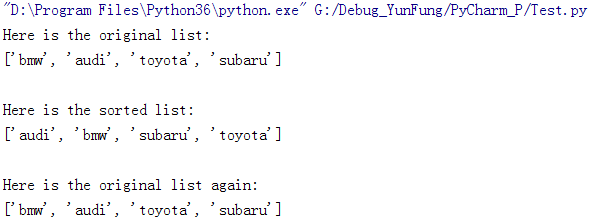Python學習筆記2_列表簡介
1.1 列表是什麽
在Python中,用方括號([])來表示列表,並用逗號來分隔其中的元素。
列表是有序集合,因此要訪問列表的任何元素,只需將該元素的位置或索引告訴Python即可。Python為訪問最後一個列表元素提供了一種特殊語法。通過將索引指定為-1,可讓Python返回最後一個列表元素:
bicycles = [‘trek‘, ‘cannondale‘, ‘redline‘, ‘specialized‘] print(bicycles) print(bicycles[0]) print(bicycles[-1])

1.2 修改、添加和刪除元素
1. 修改
motorcycles = [‘honda‘, ‘yamaha‘, ‘suzuki‘] print(motorcycles) motorcycles[0] = ‘ducati‘ print(motorcycles)
![]()
2. 在列表中添加元素
1) 在列表末尾添加元素,方法append()將元素‘ducati‘添加到了列表末尾
motorcycles = [‘honda‘, ‘yamaha‘, ‘suzuki‘] print(motorcycles) motorcycles.append(‘ducati‘) print(motorcycles) motorcycles= [] motorcycles.append(‘honda‘) motorcycles.append(‘yamaha‘) motorcycles.append(‘suzuki‘) print(motorcycles)

2) 在列表中插入元素,使用方法insert()可在列表的任何位置添加新元素
motorcycles = [‘honda‘, ‘yamaha‘, ‘suzuki‘] motorcycles.insert(0, ‘ducati‘) print(motorcycles)
![]()
3)從列表中刪除元素,
● 使用del語句刪除元素,如果知道要刪除的元素在列表中的位置,可使用del語句
motorcycles = [‘honda‘, ‘yamaha‘, ‘suzuki‘] print(motorcycles) del motorcycles[0] print(motorcycles)
![]()
● 使用方法pop()刪除元素,方法pop()可刪除列表末尾的元素,並讓你能夠接著使用它。術語彈出(pop)源自這樣的類比:列表就像一個棧,而刪除列表末尾的元素相 當於彈出棧頂元素。 實際上,可以使用pop()來刪除列表中任何位置的元素,只需在括號中指定要刪除的元素的索引即可。
motorcycles = [‘honda‘, ‘yamaha‘, ‘suzuki‘] print(motorcycles) popped_motorcycle = motorcycles.pop() print(motorcycles) print(popped_motorcycle)

● 根據值刪除元素,有時候,不知道要從列表中刪除的值所處的位置。如果只知道要刪除的元素的值,可使用方法remove() 。方法remove()只刪除第一個指定的值。如 果要刪除的值可能在列表中出現多次,就需要使用循環來判斷是否刪除了所有這樣的值。
motorcycles = [‘honda‘, ‘yamaha‘, ‘suzuki‘, ‘ducati‘] print(motorcycles) motorcycles.remove(‘ducati‘) print(motorcycles)
![]()
1.3 組織列表
在你創建的列表中,元素的排列順序常常是無法預測的,因為你並非總能控制用戶提供數據的順序。
1. 使用方法sort()對列表進行永久性排序
假設你有一個汽車列表,並要讓其中的汽車按字母順序排列。方法sort()永久性地修改了列表元素的排列順序,無法恢復到原來的排列順序。還可以按與字母順序相反的順序排列列表元素,為此,只需向sort()方法傳遞參數reverse=True。
cars = [‘bmw‘, ‘audi‘, ‘toyota‘, ‘subaru‘] cars.sort() print(cars) cars.sort(reverse=True) print(cars)
![]()
2. 使用函數sorted()對列表進行臨時排序
要保留列表元素原來的排列順序,同時以特定的順序呈現它們,可使用函數sorted()。
cars = [‘bmw‘, ‘audi‘, ‘toyota‘, ‘subaru‘] print("Here is the original list:") print(cars) print("\nHere is the sorted list:") print(sorted(cars)) print("\nHere is the original list again:") print(cars)

3. 倒著打印列表
要反轉列表元素的排列順序,可使用方法reverse()。方法reverse()永久性地修改列表元素的排列順序,但可隨時恢復到原來的排列順序,為此只需對列表再次調用reverse()即可。
cars = [‘bmw‘, ‘audi‘, ‘toyota‘, ‘subaru‘] print(cars) cars.reverse() print(cars)
![]()
4. 確定列表的長度
使用函數len()可快速獲悉列表的長度
cars = [‘bmw‘, ‘audi‘, ‘toyota‘, ‘subaru‘] a=len(cars) print(a)
![]()
Python學習筆記2_列表簡介
